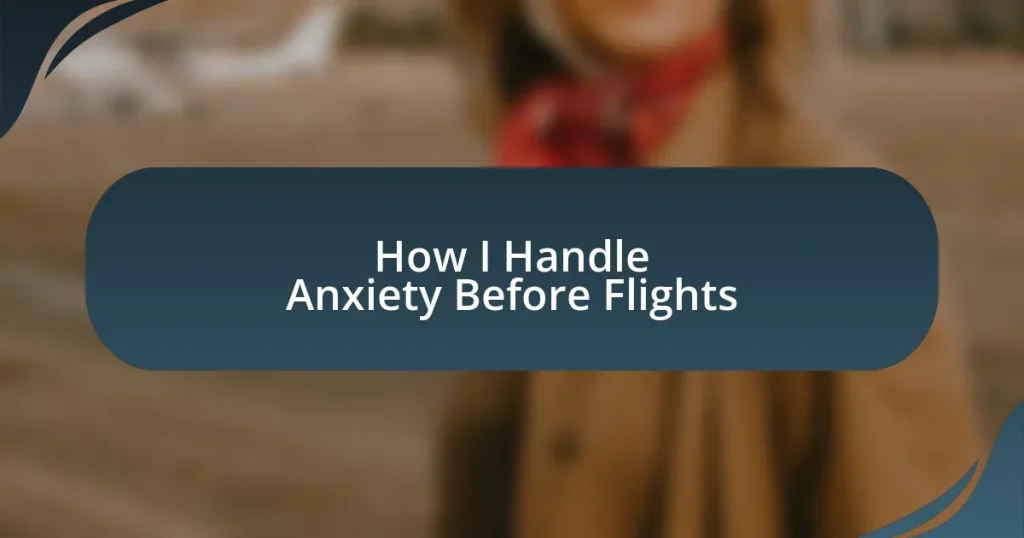Key takeaways:
- Flight anxiety can stem from various sources, including a lack of control and past negative experiences.
- Common signs of anxiety before flying include increased heart rate, sweating, and trouble concentrating.
- Effective coping strategies include deep breathing exercises, mindfulness techniques, and preparing a distraction kit.
- Post-flight reflections, such as journaling and deep breathing, can help process anxiety and transition to relaxation.

Understanding flight anxiety
Flight anxiety, for many, is a real challenge that can stem from various sources, including fear of heights, claustrophobia, or even bad past experiences. I often find myself wondering, what is it that makes me so uneasy before a flight? It’s fascinating how our minds can conjure up images of worst-case scenarios, even when statistically, flying is incredibly safe.
In my experience, the anticipation can be just as stressful as the flight itself. I remember vividly a trip where my heart raced at the thought of boarding the plane. The moment I stepped into that cramped cabin, I question myself—why do I let this fear win? Understanding that these feelings are common can bring some comfort, knowing I’m not alone in this struggle.
Digging deeper, I’ve realized that sometimes, flight anxiety is rooted in a lack of control. During a turbulent flight once, I felt utterly helpless, and it struck me how much I crave stability in my life. This connection between control and anxiety is often overlooked. I often ask myself: how can acknowledging this help me cope better? Embracing this understanding might just be the first step to overcoming it.
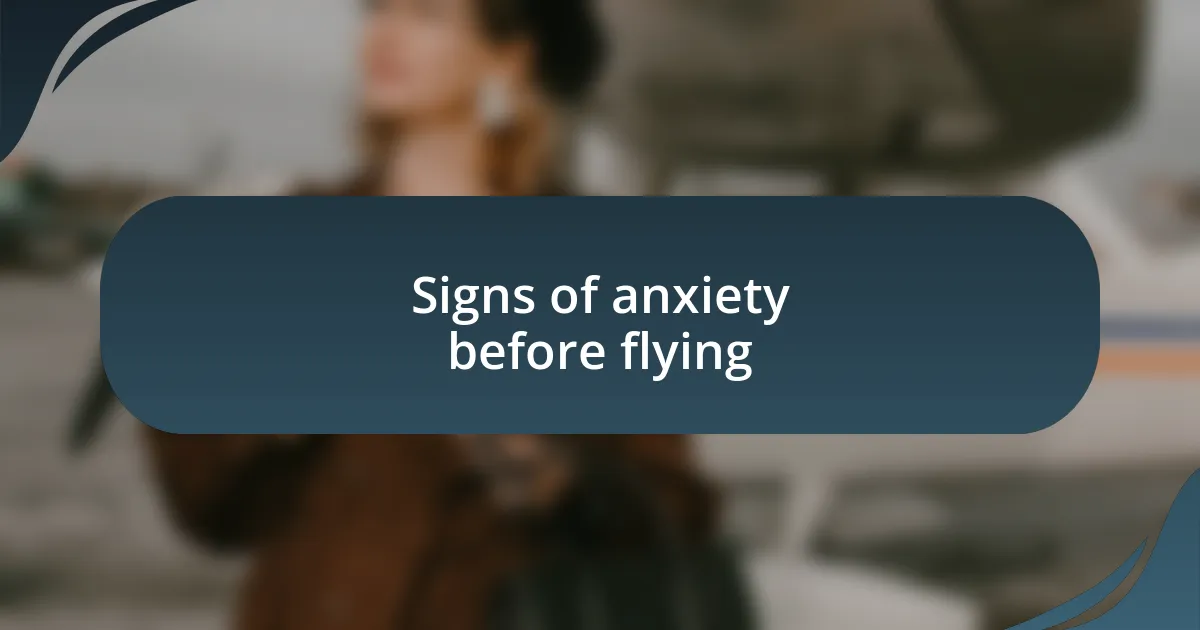
Signs of anxiety before flying
The signs of anxiety before flying can manifest in various ways, often creeping up on us right as we prepare for the journey. Personally, I notice that my stomach begins to turn when I even think about check-in. The anticipation can be overwhelming, triggering physical symptoms that are hard to ignore.
Some common signs I’ve encountered in myself and others include:
– Increased heart rate
– Shallow breathing
– Sweaty palms
– Restlessness or fidgeting
– Trouble concentrating on anything else
– Nausea or a knot in the stomach
Often, it isn’t just the nervousness; it’s a combination of physical and emotional responses swirling together. When I find myself pacing in the airport terminal, I realize how these symptoms can spiral. It’s almost as if my body is preparing for an unseen battle, and acknowledging these feelings is crucial.
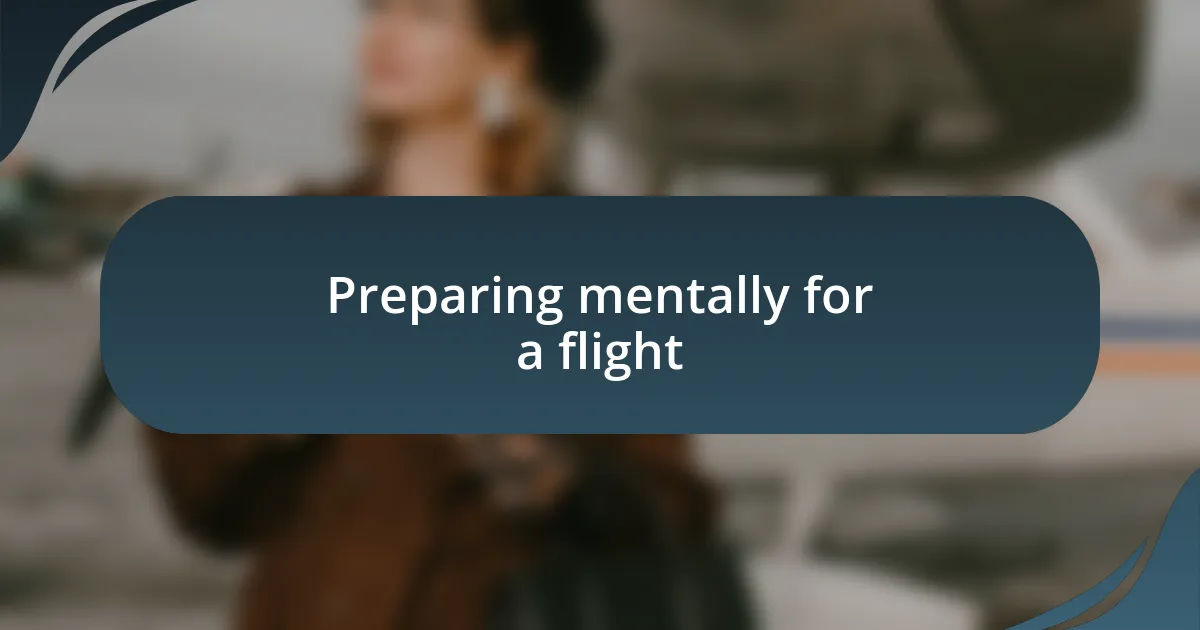
Preparing mentally for a flight
Preparing mentally for a flight involves some intentional strategies that can make all the difference. For me, creating a pre-flight routine is vital. I often take a moment to visualize my journey, focusing on the excitement of reaching my destination rather than the flight itself. This shift in perspective helps me manage the anxiety that tends to creep in.
Another technique I find effective is grounding myself through mindfulness exercises. Before boarding, I might take a few deep breaths or use short meditation techniques. Focusing on my breath as I inhale deeply helps me center my thoughts, diminishing the anxious feelings swirling in my mind. I remember sitting in the terminal once, feeling overwhelmed, and just a few minutes of mindful breathing transformed my mindset.
Additionally, I like to prepare a distraction kit for the flight. This can include a good book, music playlists, or even podcasts that capture my attention. Having these handy not only distracts me during the flight but also gives me something to look forward to. It makes the experience feel less daunting when I have activities ready to dive into.
| Technique | Description |
|---|---|
| Visualize the journey | Focus on the excitement of arriving rather than the stress of flying. |
| Mindfulness exercises | Practice deep breathing or meditation to center your thoughts. |
| Distraction kit | Prepare activities like books or music to keep yourself engaged during the flight. |
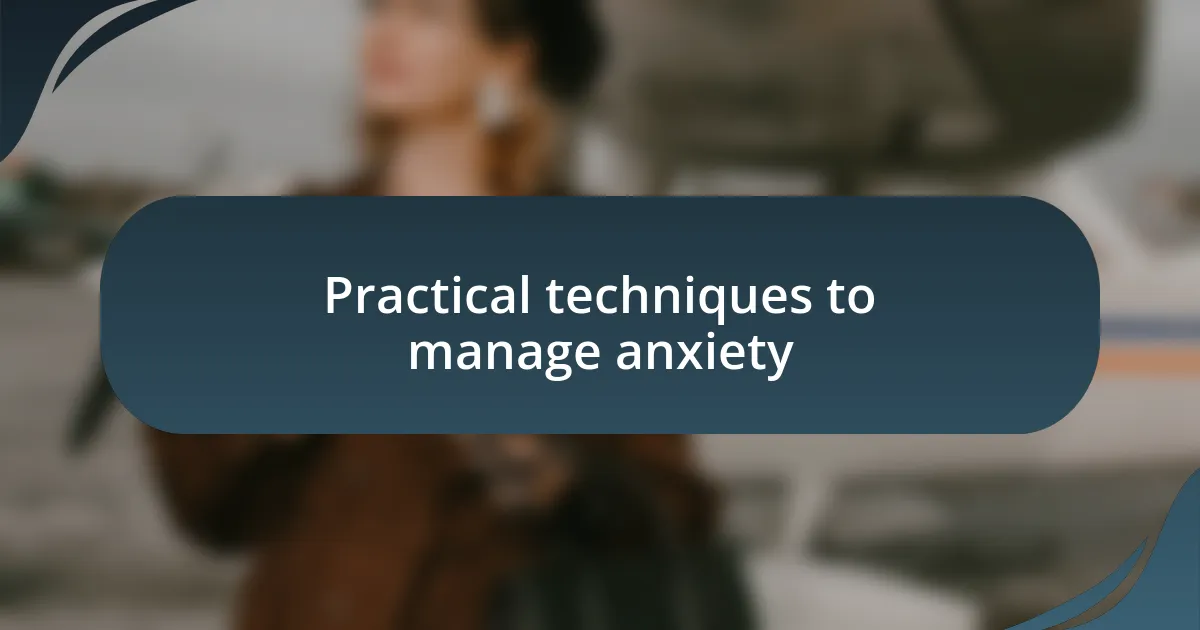
Practical techniques to manage anxiety
One technique that has helped me immensely is the use of positive affirmations. Before a flight, I often tell myself things like, “I am safe and in control.” It might sound simple, but affirming my safety and strength can completely shift my mindset. Have you ever noticed how words can influence your thoughts? I certainly have, especially when facing the uncertainty of flying.
Another practical approach I swear by is preparing a comfort item. I have a small, soft blanket that I always take with me. Feeling its warmth against my skin during turbulence provides a sense of security. It might seem trivial, but having that tangible comfort can make a huge difference in my anxiety levels. Have you ever held onto something comforting during stressful times? It really does create a sense of calm.
I also find it beneficial to engage in light physical activity before heading to the airport. A short walk or another form of exercise helps release endorphins, which are those wonderful mood-enhancing chemicals. I once took a brisk walk just before boarding some years ago, and it surprisingly lifted my spirits. Feeling the fresh air filled me with a sense of empowerment, reminding me that I could tackle whatever lay ahead. What physical activity energizes you?
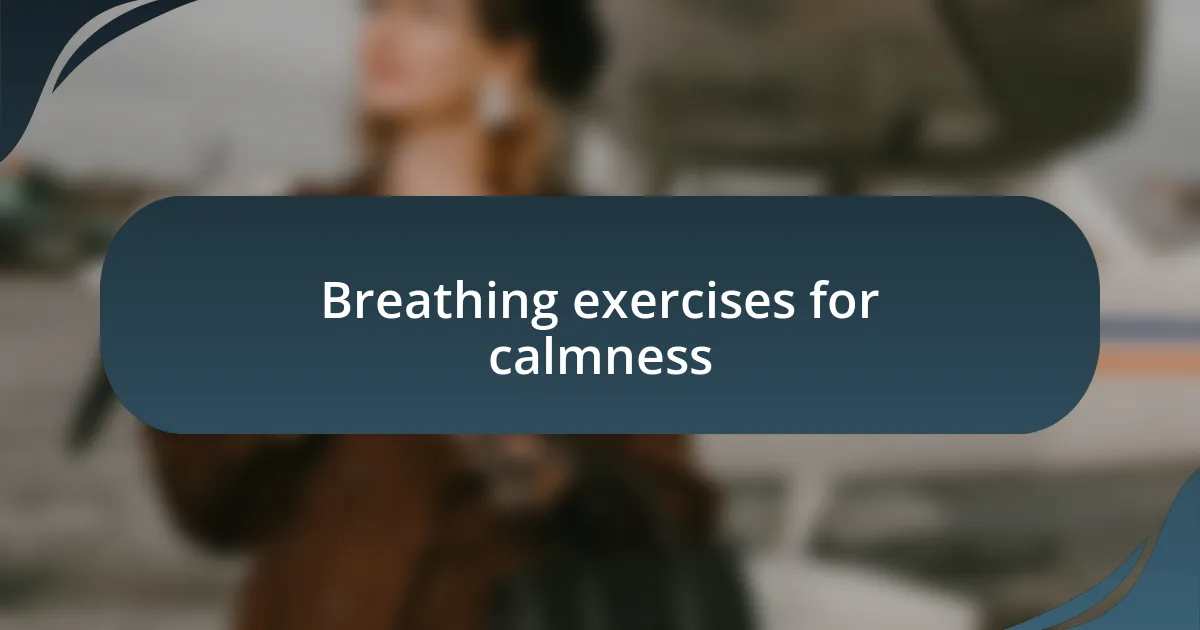
Breathing exercises for calmness
Focusing on my breath has become a game-changer for managing anxiety. I like to practice a technique called deep breathing, where I inhale slowly through my nose for a count of four, hold it for four, and then exhale through my mouth for six. It feels like I’m letting go of the anxiety with every exhale, releasing that tightness in my chest. Have you ever tried counting your breaths? It’s fascinating how such a simple act can create a ripple effect of calm.
Another method I use is the 4-7-8 breathing technique, which draws my attention away from fearful thoughts. Inhale for four seconds, hold for seven, and then exhale for a full eight seconds. Last time I did this before a flight, I noticed my heartbeat slowing down, almost synchronizing with the rhythm of my breaths. Isn’t it incredible how our bodies respond to such mindful practices?
During moments of heightened stress in the airport, I’ll often step aside and practice box breathing. This involves inhaling deeply for four counts, holding for four, exhaling for four, and then pausing for another four. I distinctly remember doing this in a crowded terminal just before my flight, and the world around me faded as I found my center. It taught me that no matter where I am, I can always return to my breath for guidance. Does it ever amaze you how the simplest things can ground us?
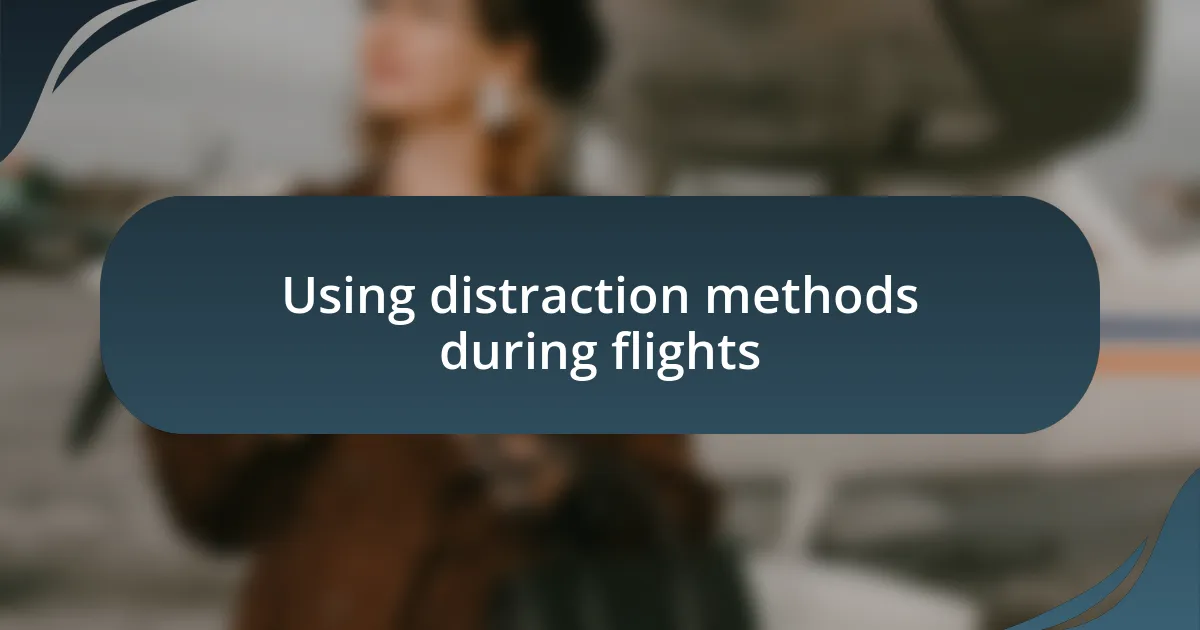
Using distraction methods during flights
Finding ways to distract myself during flights has been a key tool in managing my anxiety. One of my go-to strategies is getting lost in a captivating novel or an engaging podcast. I remember a flight where I opted for a mystery audiobook; the story completely absorbed me. Suddenly, the noise of the plane faded, and I was right there with the characters, unraveling clues instead of focusing on my nerves.
Sometimes, I turn to my favorite playlists filled with upbeat music. Each song feels like a little power-up, transforming my mood and helping me escape the claustrophobia of the cabin. I still recall a particular flight where I played a mix of my favorite songs, and with each beat, I felt my tension melt away. It was as if I had transported myself to a concert rather than being in a confined space.
Another method that works wonders for me is playing games on my phone. Simple puzzles or word games engage my brain enough to divert my attention from the flight itself. There’s a certain satisfaction in completing a level or solving a challenge that not only keeps my mind occupied but also boosts my confidence. Have you noticed how engaging activities can transform our focus? For me, it’s a delightful way to pass time and ease my worries until we touch down.
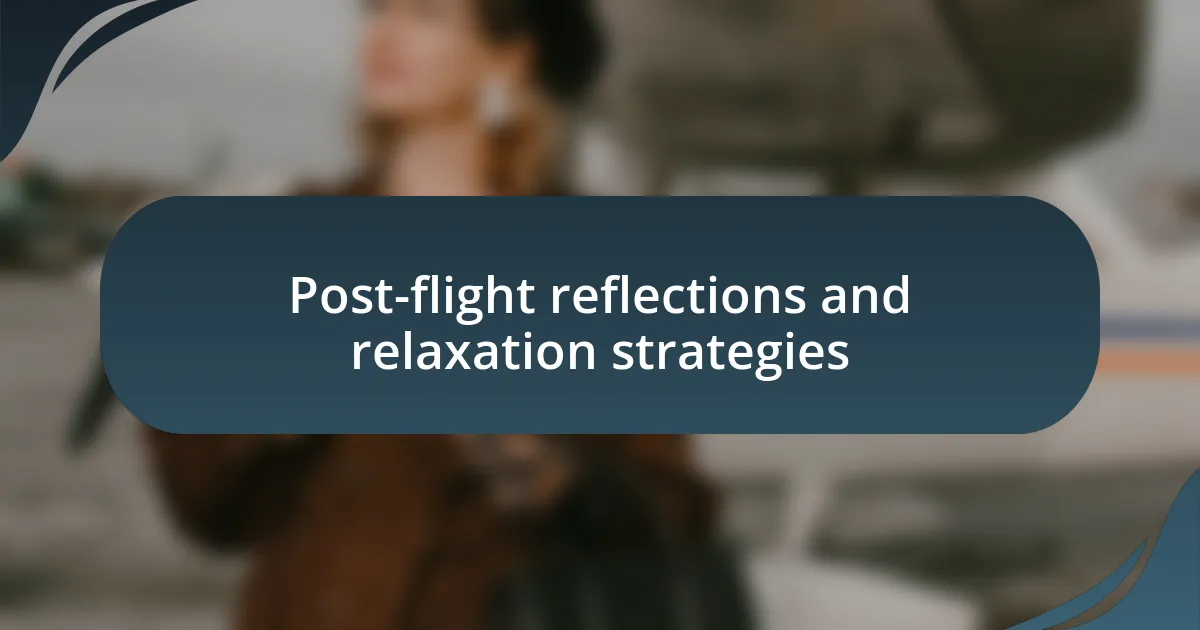
Post-flight reflections and relaxation strategies
Post-flight reflections often reveal insights that are easy to overlook in the rush of travel. After landing, I like to take a moment to jot down my thoughts in a travel journal. Reflecting on the experience helps me process any lingering anxiety and allows me to discover patterns in my emotions. Have you ever noticed how beneficial it is to articulate our feelings? For me, this practice often clarifies my thoughts and reduces stress.
In addition to journaling, I find deep breathing exercises incredibly helpful for unwinding after a flight. Once I’m off the plane, I take a few moments to close my eyes and focus on my breath. Inhale deeply for four counts, hold for four, and exhale for four. This simple technique grounds me and dissipates any residual anxiety, reminding me of the comfort of solid ground. It’s like hitting the reset button for my mind and body.
Moreover, I enjoy engaging in a post-flight ritual to shift my focus back to relaxation. Whether it’s indulging in a warm cup of herbal tea or taking a leisurely walk once I arrive at my destination, these moments help solidify the transition from travel to tranquility. What’s your preferred way to wind down? I find that these small rituals can make a significant difference in how I feel and help me embrace my surroundings anew.











